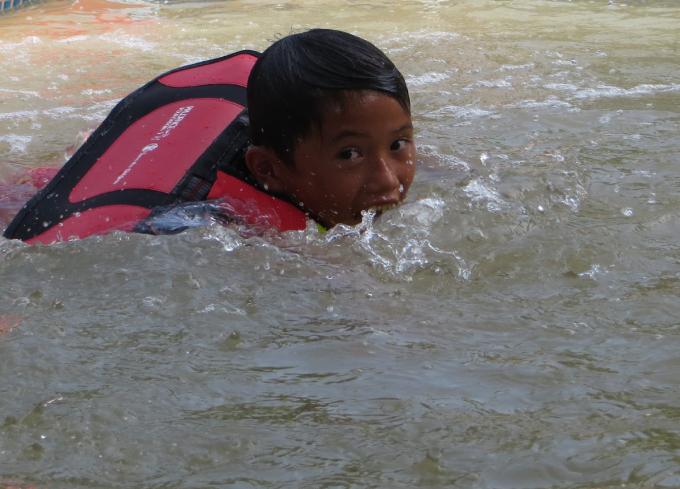Climate Change Risks and Resilience in Urban Children
Climate change is a key challenge facing children all over the world, making child rights difficult to enjoy by children and safeguard by adults, society and governments. Research now shows that climate change significantly impacts children’s right to life, survival and development. However, in the urban context, there is little research looking specifically at the vulnerabilities of children to climate change impacts. City case studies carried out by Save the Children in Asia seeks to better understand the risks faced by vulnerable children in urban areas, and how climate change may exacerbate these.

No doubt children’s still evolving development makes them physiologically and metabolically less able than adults to cope with high exposure to hazards. The IPCC estimates that at least 175 million children will be affected by disasters annually by 2015. WHO estimates that more than 85% of the global disease burden due to climate change occurs in children under 5. According to The International Food Policy Research Institute (IFPRI) report Climate Change: Impact on Agriculture and Costs of Adaptation forecasts that by 2050 rice prices will increase between 32 and 37% as a result of climate change. The report shows that yield losses in rice could be between 10 and 15%. Declining maize and wheat production since the 1980s due to climate change are believed to contribute to a projected additional 25 million malnourished children globally by 2050. Climate change also poses increasing risks to education as climate-related shocks result in more girls being taken out of school than boys, boys dropping out of schools for securing paid work and for other reasons thus undermining efforts toward universal education.
“Our house is located near the canal. Every year our house floods during the rainy season. Because of this I failed to go to school for a week. I was also not able to do the homework for English which was hard for me while staying at home. When I attended school after a week, my teacher did not care about my situation. Instead I was beaten mercilessly. I suffered from fever immediately after the incident. My parents tried very hard to send me back to school but I did not go back to school since the teacher had beaten me for no fault of mine.”, Said, a 13-year-old boy from Khulna, Bangladesh who dropped out of school at 11 and now works long hours in a restaurant.
Climate change presents particularly strong challenges to children in the Global South, who are already at a disadvantage due to poverty, migration, rapid urbanization, inequitable and poor access to infrastructure, education, health and other protective services. More than 700 million children below the age of 15 (often comprising as much as 40% of the population or more) live in the 20 countries deemed at “extreme risk” from climate change (mainly in the belt around and immediately north of the equator). These represent some of the fastest urbanizing countries in the world. Included in this group are many Asian countries with some of the largest and most populated cities in the world, located on the floodplains of major rivers and typhoon prone coastal areas which make them susceptible to significant impacts of climate change both now and into the future. A large proportion of the population in Asian countries and indeed in Asian cities are infants, children and adolescents who arguably represent one of the most vulnerable categories subjected to a spectrum of risks from climate change in cities. Yet few urban adaptation and resilience building programmes in Asia focus on children.
Knowledge Gap
While understanding of the impacts of climate change is advancing rapidly across the globe, most studies focus on the vulnerabilities and experiences of adults. Few studies that did focus on children did so to understand vulnerabilities at the country level. The challenges facing children in urban areas differ significantly to those faced by rural children (though there are many overlaps) and undoubtedly children living in urban poverty are more vulnerable to climate related shocks and stresses due to the inherent vulnerabilities of their living environments.
Research on child-centred adaptation in urban communities is virtually non-existent. Given the dearth of research on these issues, it is unclear whether urban programs run by Save the Children and other child-focused organisations are systematically building children’s resilience to the specific challenges climate change will bring to their lives. Specific research into the kinds of additional challenges climatic change will bring to the lives of poor children in urban communities is urgently required to enable child-focused organisations to integrate building climate change resilience into sector-based activities in their urban programming.
Research Objectives
In order to address these research gaps and provide a framework of child-centred adaptation measures to Country Offices, Save the Children, with funding support from the International Institute for Environment and Development (IIED) (via the Rockefeller Foundation-supported Asian Cities Climate Change Resilience Network), commissioned a multi-city study to understand the risks climate change poses to the development of urban children in three Asian countries Bangladesh, the Philippines, and Vietnam. The cities chosen for this study are secondary cities with less than 1 million inhabitants (complementing the Asian megacities study by PLAN-IIED) and include Khulna in Bangladesh, Da Nang in Vietnam and Manolos in the Philippines.
Sharing Workshop
Save the Children International (SCI) is organizing an international workshop on September 23, 2014 in Hanoi, Vietnam, to present the research result of SC in Climate Change Risk and Resilience in Urban Children in Vietnam, Bangladesh & Philippines. An important goal of the workshop is to receive feedback from other organizations and discuss the implications of children’s vulnerability and adaptation activities to climate change in urban environments
 Vietnam
Vietnam